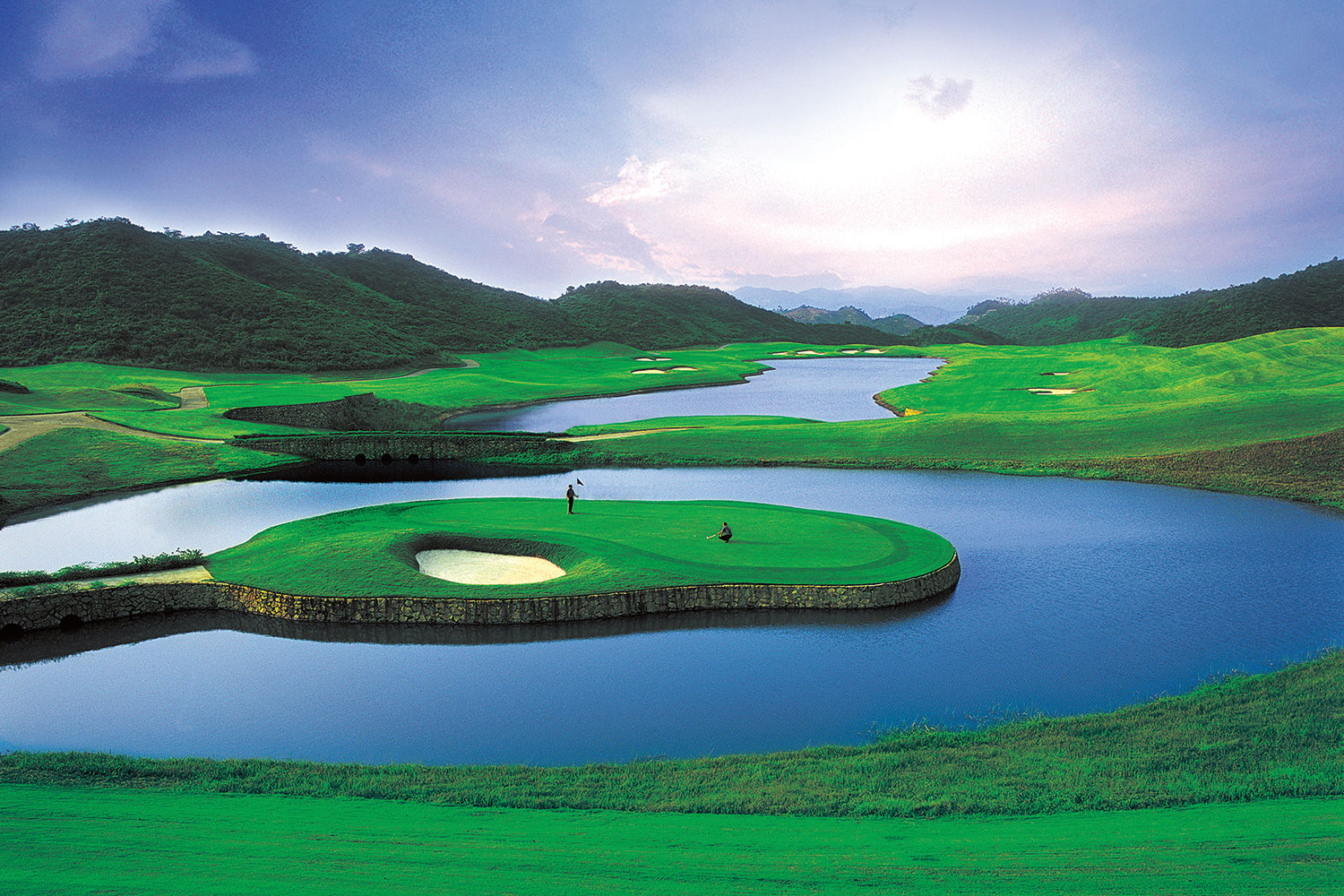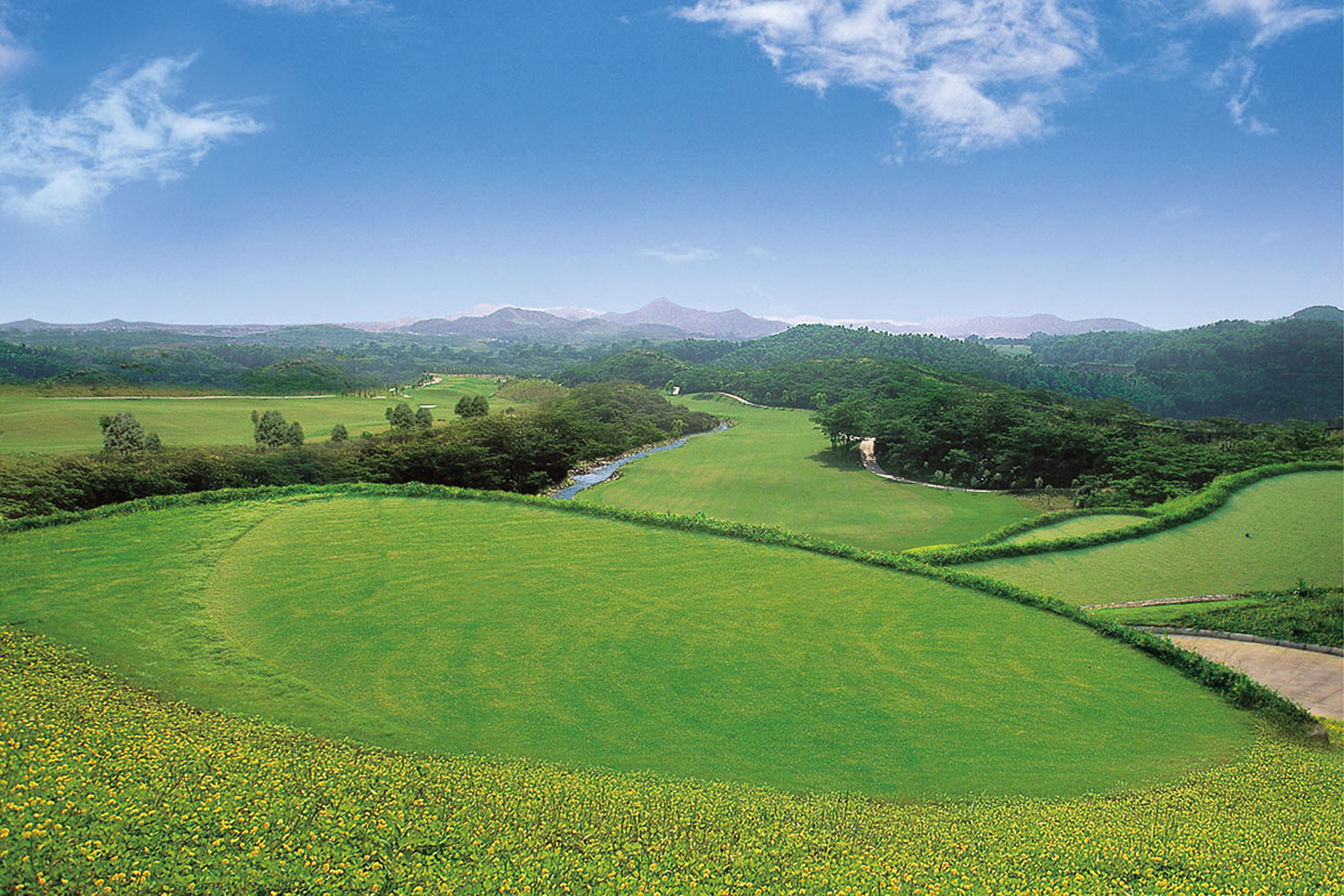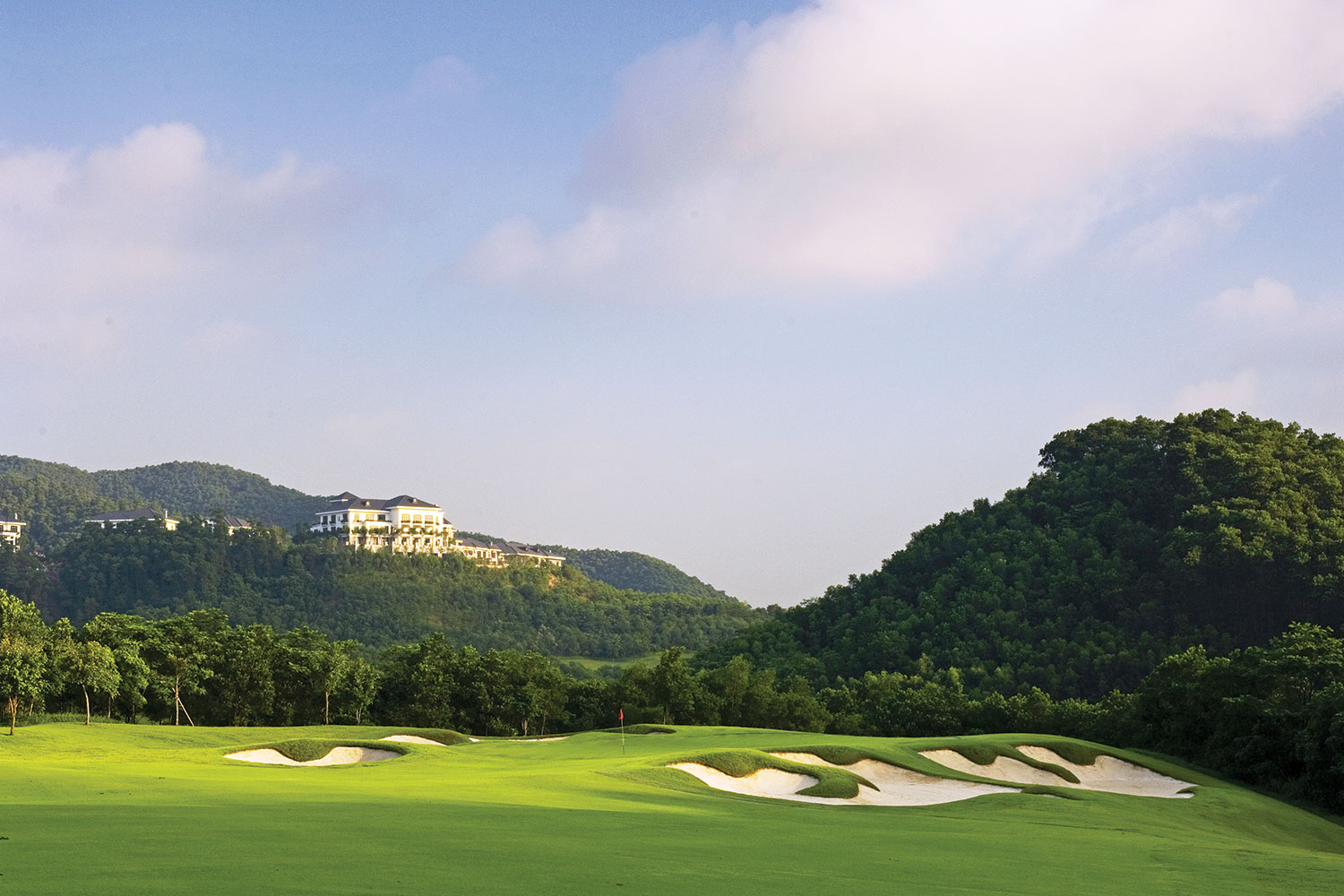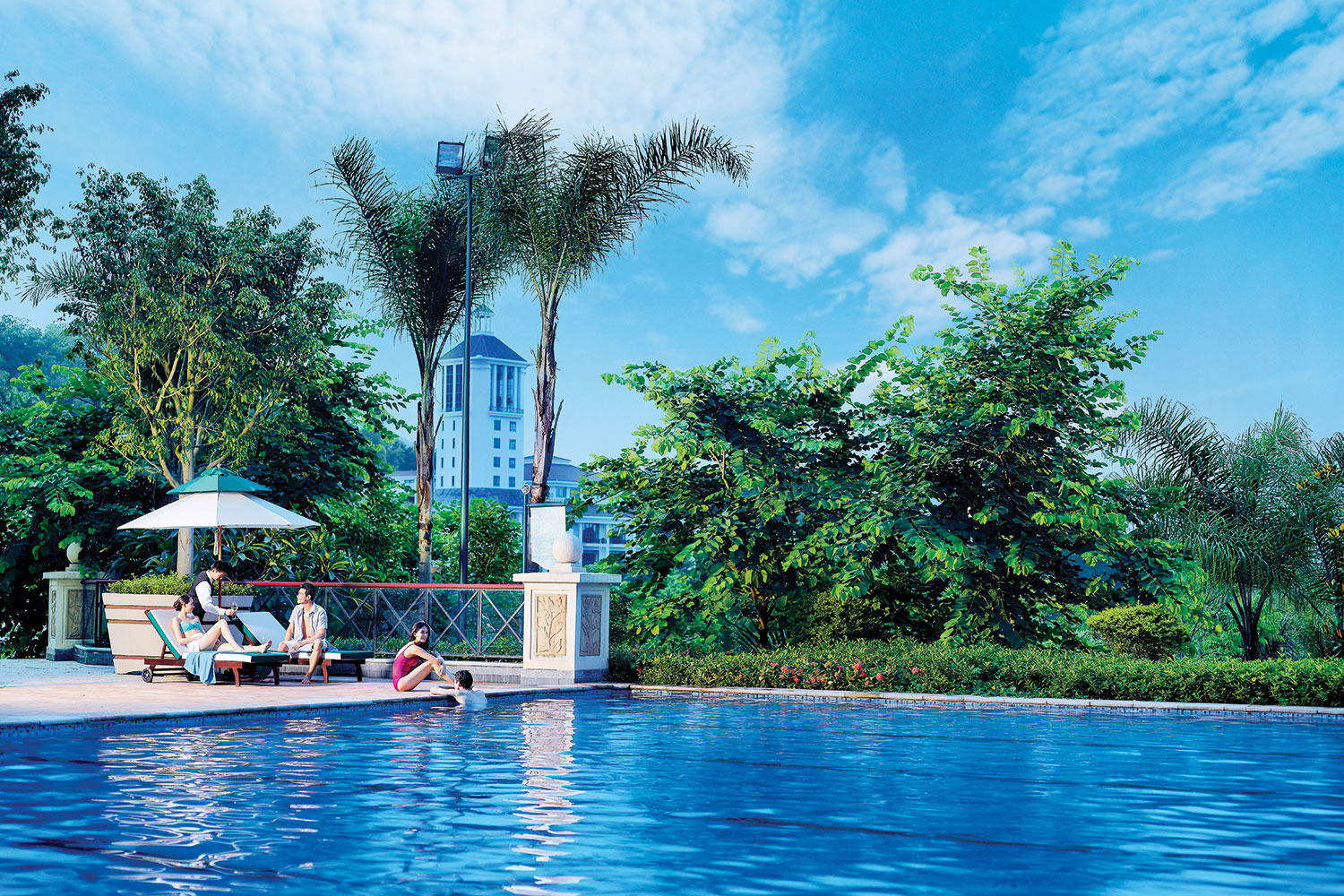THE idea of 12 golf courses in one location boggles the mind more than a downhill 60-footer with three different breaks. For seasoned golf travellers, the very notion of being within arm’s reach of so many courses without having to pack and repack or move along down the road is almost entirely foreign. Foreign, that is, unless you’ve been to Mission Hills Shenzhen.
Technically 22 courses – spanning 10 on the island of Haikou and the remaining dozen in Shenzhen, an hour or so drive north of Hong Kong – Mission Hills is a veritable sea of choice for golfers. What was formerly a construction garbage dumpsite at Shenzhen is now the lion’s share of what is officially the largest golf club in the world.
It represented a brave venture and one that required great vision and sizeable investment. Dr Ken Chu, the chairman and chief executive of the Mission Hills Group, says his father, industrialist and Mission Hills founder David Chu, treated the concept as “his baby”. It was never necessarily intended to be so huge; rather that aspect evolved through popularity.

“There was no mindset of it being large,” Dr Chu says. “It grew because of the demand, not for the ego. And then it snowballed. The popularity of golf snowballed because there was a lot of business interaction with the East and the West, and then golf became the natural medium to link the East and West. It was an extension of the office, because how else can you tie the client down for four-and-a-half hours? It became a very popular entrepreneur, business language.”
And why 12 golf courses? It was a nice number to round off, Dr Chu says. There are 12 numbers on a clock, 12 months in a year and 12 horoscope or zodiac signs. Numerology is huge in Chinese culture and 12 represents “profession”, according to the good doctor. That said, even once all dozen courses were officially opened in 2004, Mission Hills could have expanded further had the government moratorium on course construction not taken effect.
“Avid golfers come because variety is the spice of life,” Dr Chu says. “One big destination, multiple courses, less travel, fewer headaches. Golfers are very spoilt; they get even more spoilt when they come to China because of the caddies and it’s so affordable.”

Visitors from 129 countries have played golf at Mission Hills, spanning Iceland to Argentina, Russia to Namibia. While some remark that it ‘doesn’t feel like China’, the fully integrated nature of the resort holds a drawing power for people whether they play golf or not. Yet, if there is a place in the world for all golfers to congregate, this is surely it.
All You Can Handle
With a dozen courses, it’s understandable to think the complex might possess a hypnotic quality where each layout blends into the next. Not so. Some of the courses share similar terrain and design traits, however astute eyes will see at least subtle differences. Then there are the less subtle ones. For starters, the 12 Mission Hills Shenzhen courses are split across three different locations: five at Shenzhen, two at Mid-Valley and five at Dongguan. The Shenzhen courses (World Cup, Els, Vijay, Zhang Lian Wei and Ozaki) occupy less undulating terrain and are generally more open in nature and a shade easier on the golfer. The Dongguan five (Olazabal, Norman, Rose-Poulter, Annika and Leadbetter) are far more dramatic, with many of the courses pushing up into the base of the surrounding mountains, while the Mid-Valley duo (Faldo and Pete Dye) are a midpoint between the other two, both literally and for landform. Australian golfers will notice touches of home as eucalypts dot several of the courses.
Each person attributed to the golf course of their name had varying levels of design input. The principal designers, as at Mission Hills Haikou (Australian Golf Digest, June 2017) were Lee Schmidt and Brian Curley, although each course required at very least the approval and sign-off of the eponymous golfer. For example, Annika Sorenstam was heavily involved, David Duval less so.

Some distance separates each of the three locations, with separate clubhouses and resorts for the Shenzhen and Dongguan sides. Shuttle buses operate between each site, but can take up to 40 minutes between the two main locations. And the caddies are usually assigned to one or the other. So the caddie who gave you all the great reads and club selections on your first day playing the Leadbetter course, for instance, is unlikely to be allowed to caddie for you across on the Els course.
Of the 12, only the Pete Dye course and the Zhang (a par-3 course) are not accessible to visiting golfers and hotel guests. The resort juggles its maintenance schedule to the point that a course or two might be out of play for a day here and there, but a stay of any reasonable length is likely to provide the chance to tour the 10 courses guests can access [see below].
There have been changes over the years. The original Nicklaus layout was re-named the World Cup course after Mission Hills staged the 1995 World Cup of Golf. The Rose-Poulter course was initially the Duval course. Either a lack of interest from the 2001 British Open champion or the decline in his golf game led to the name change and a series of design tweaks. Rose-Poulter is viewed as more of a matchplay layout with larger teeing grounds that permit greater flexibility in course set-up – always a key ingredient in one-on-one play. The two namesakes staged an exhibition match in 2013 to herald the re-imagining of the course, with Justin Rose walloping countryman Ian Poulter, 3&2, in the nine-hole sprint.

I asked everybody I met at Mission Hills Shenzhen – caddies, members, staff, directors of golf, the resort’s PGA professionals and more – which was their favourite course and received the full gamut of responses. And each golfer liked their chosen course for different reasons. Brian O’Donovan, who accompanied me for morning rounds on each of the Norman, Faldo and Olazabal courses, nominated the Faldo as his favourite from a pure design perspective. And that’s saying something from a guy who two years ago shot 59 around the Annika course.
Favouritism was purely subjective, although which of the courses is most difficult was almost unanimous. The Norman course is a beast. The front nine is enough of a handful before the back nine squeezes in and goes for the golfer’s throat. The course tightens and lengthens, coupling that with several drastic elevation changes. Yet arguably the most difficult aspect of the Norman course is the way the greens want to repel any ball hovering near the edges, and how chipping and pitching back aboard the target is no easy task. Your single-figure-handicap correspondent required 50 swings to cover the inward half, without a three-putt and with just one lost ball.
It’s a brawny challenge emblematic of the man himself. Our group tackled the Norman from the gold tees (one set forward from the back tees) and discovered to our horror seven holes in that thereafter the gold markers were almost exclusively on the rear teeing ground, amplifying an already difficult test. Still, most groups want to tackle the tough Norman course for the thrill of the challenge, but doing so from the appropriate set of tees is advisable here perhaps more than anywhere else.

Ironically for such a demanding layout, the coolest hole might be its shortest. The little fourth measures 134 metres from the back tees and plays slightly downhill to a long, slender and bunkerless green that falls away to a lateral hazard on the left and a huge grassy mound on the right that can save an errant iron shot. A river in the background completes the vista. Aside from the enormity of the test, the best aspects of the Norman course are the terrain it covers and the isolation of each hole. Every one of the back-nine holes feels like it is in its own world, an oasis of extreme golf.
The club considers the Olazabal course as its championship layout. It hosted the 2012 WGC–HSBC Champions, won by Poulter, on the lone occasion the tournament ventured away from its Shanghai home. Olazabal’s par-5 15th hole is the most iconic of the 216 holes at Mission Hills Shenzhen, a 530-metre challenge that snakes left around a huge lake and 24 bunkers to a green perched above the water.
Perhaps the most interesting layout is the Annika course, where Sorenstam insisted on something that is almost a rarity in golf courses the world over: the women’s tees had to take precedent. In other words, the entire course was designed with the red tees as the principal teeing ground with the rear tees flowing back from there, rather than the back markers framing each hole and the front tees simply finding a home farther up.

The Annika is also one of those rare courses with six par 3s, six par 4s and six par 5 holes. It’s a great test for all golfers – female or male, regardless of the tees chosen – and offers some of the best scenery on the Dongguan side of the resort. The tee of the par-3 seventh hole sits on the highest part of the property and trundles downhill to a green that looks like it’s sliding off the edge of a mountain. The views up and down the valley are spectacular and provide a snapshot of the magnitude of this enormous golf complex. Conversely, from below, the seventh green complex sits like a pulpit above the other Dongguan courses.
Points Of Difference
One aspect of the Mission Hills courses first-timers need to be aware of is the sand is notoriously soft. The bunker faces are known for swallowing balls entirely. Indeed, on the 15th hole of the Faldo course, we searched the face of one of the greenside bunkers for several minutes for my playing partner’s ball, while mine sat almost fully plugged farther up the face after a floating wedge shot came up short. Such a predicament has led to what’s known as a “China drop” where free relief is available from severely buried lies via a drop elsewhere in the bunker. Whether your golf conscience permits you to take up the offer is up to you.
One eerie aspect to playing golf at Mission Hills is noting the vast number of empty homes adjoining some of the courses. They’re sold, but represent possibly the third, fourth or even fifth residence for the owner, so might sit vacant for as much as 11 months a year.

As is the case across Asia, caddies are all but mandatory, although you’d never want to attack one of these courses without one. The (entirely female) armada of caddies at Mission Hills are helpful, attentive and dutiful to the extreme. They’ll do things like feed fruit to golfers during the round as well as rake bunkers, fill divots and read greens.
Mei Li, who caddied for me on my last of three rounds at Mission Hills, was the best green-reader I’ve seen throughout Asia. I holed putts from all over the Olazabal course’s greens in silly fashion, lipping out a handful of other times. Unreliable putting stroke or not, there’s an inherent confidence in standing over a putt that two pairs of eyes have confirmed the line for instead of one.
It truly is the little things that set Mission Hills Shenzhen apart, a message propagated by the chairman and chief executive. “It’s a family destination for all,” Dr Chu says succinctly about what is at the core of Mission Hills today. “That’s why we introduced all these other elements and facilities to promote [Mission Hills to] the entire family. Why do we exist? Our mission statement is to promote the three Hs: happy, healthy, harmonious lifestyle to all. It’s a circle – you have to balance it very well and it comes around. That’s what we exist for … and I’m happy to see a lot of smiling faces here.”
Mission Hills packages and repackages its 12 offerings in eclectic ways. One current offer combines the courses representing designers from five different continents [see below], while another brings together the quintet of layouts penned by the five British Open champions to stamp the complex. Yet even with its gargantuan golf offerings and formidable number of holes and courses, Mission Hills Shenzhen is what golfers wish to make of it. Load up and attempt all the courses if you like, or sample one or two from each of the three different locales to get a feel for the place in a more demure approach. By all means, stay for four nights or a fortnight – there’s enough to keep you occupied for an eternity.
A Delightful And Dangerous Dozen
The 12 courses of Mission Hills Shenzen are divided into three bordering localities.
Shenzhen
World Cup: The Jack Nicklaus-designed layout is named for the event it hosted in 1995, the final year of Fred Couples and Davis Love III’s World Cup four-peat, with Australia’s Steve Elkington and Robert Allenby left in their wake as runners-up. Typically Nicklausian in design, the World Cup course is spacious with a healthy smattering of bunkers and water hazards in a spectator-friendly arena.
Vijay: Shorter, tighter and with more undulating putting surfaces, the Vijay Singh course pays homage to several famous courses around the world. The par-5 10th hole, for instance, bears a resemblance to the closing hole at Pebble Beach including a green site beside a rock wall. Waste bunkers and an abundance of water hazards (in play on 14 of the 18 holes) are additional design hallmarks.

Ozaki: Japanese star ‘Jumbo’ Ozaki played a big and brash game and his namesake course owns a style to match. The Ozaki layout possesses large features: large playing corridors, large greens and a large number of obstacles in the form of lakes, bunkers and tracts of native vegetation. Elevation changes – particularly at the steeply downhill par-3 sixth hole – add further charm and character.
Els: The Ernie Els course was intended to be a composition of lush forests and pristine turf to reflect the South African’s homeland. That result was achieved, although the more interesting aspect of the Els course is its twisting nature and how golfers never confront two holes running in the same direction. The drive from the fourth is a highlight, a par 5 played from a scenic, dramatically elevated tee to a narrow, snaking fairway below.
Zhang Lian Wei: China’s first golfer to make a global impact penned a par-3 course – the first in China – that recalls the green complexes of famous short holes the world over. No hole surpasses 195 yards in length and three are shorter than 100, even from the back tees.
Mid-Valley
Faldo: Home to China’s only island-green hole, Sir Nick Faldo’s contribution to Mission Hills is a pleasant and challenging stroll across the only publicly accessible layout of the two Mid-Valley courses. The closing stretch builds a crescendo to the round via a driveable par 4 at the 15th, the island-green 16th and two water-laden finishing holes: a long par 4 and a short par 5.

Pete Dye: Solely the preserve of Mission Hills’ members, the design ambition here was to create a distinctive look. As such, quirky Pete Dye traits are in full flow, including railway sleepers, pot bunkers, native grasses, expansive waste areas and confounding, undulating greens. Dye’s layout is not long but packs punches in ways other than distance alone.
Dongguan
Olazabal: Jose Maria Olazabal was known as a master from the sand and the Olazabal course highlights that skill through striking bunkering across the 18 holes. A total of 151 bunkers (24 on the 15th hole alone) dot the landscape as the premier layout at Mission Hills – and host to three World Cups and a WGC tournament – climbs and descends some of the best terrain in the valley containing the Dongguan courses. Not to be missed is the fascinating, eye-catching, crescent-shaped par-5 15th hole that wraps around a large lake along its left side.

Annika: Here’s a first – a course designed with the red tees as a priority! That’s the point of difference on Annika Sorenstam’s layout, yet it is a course that remains tempting and demanding from the longer tees. Another difference: there are six par 3s, six par 4s and six par 5s, which is always an intriguing configuration. The Annika course also affords some of the best mountain views of the Dongguan quintet.
Rose-Poulter: Initially penned under David Duval’s moniker, the Justin Rose-Ian Poulter course was designed with matchplay in mind more than strokeplay. The idea is for golfers to take more chances and ignore the 18-hole tally and instead try to outplay your opponent. Therefore, the layout provides a larger range of flowing teeing grounds compared to most courses as well as shorter par 4s.

Leadbetter: Fittingly for a golf instructor, the David Leadbetter course places an emphasis on novice play by providing elevated tees and wide playing corridors. The less-intimidating approach does not dilute the challenge for better golfers, however; more likely is for fewer balls to be lost along the way. The subtle demands of the course include sloping fairways and sprawling bunkers.
Norman: In stark contrast to the Leadbetter layout, Greg Norman’s course is the bear of the dozen. It also affords some of the best scenery at Mission Hills but your game needs to be in peak shape. Characterised by demanding shots at every turn and journeys through, up and down a chain of valleys, the Norman is a handful for any golfer. The 14th hole typifies the test: a 644-yard (589-metre) uphill, doglegging brute of a par 5.
Continental Drift
Golf enthusiasts now have the opportunity to achieve a bucket-list quest of playing golf in five different continents … in just five days.
Mission Hills is offering a special five-day, four-night package that includes golf on five of its courses by world-famous designers from Europe, Africa, Asia, the Oceania and Australia.
 Golfers will first tackle the course designed by European Ryder Cup legend Jose Maria Olazabal, venue for four World Cups from 2007 to 2011 and the WGC–HSBC Champions in 2012, won by Ian Poulter. Further rounds take place on award-winning courses by two more Major champions, Ernie Els and Vijay Singh.
Golfers will first tackle the course designed by European Ryder Cup legend Jose Maria Olazabal, venue for four World Cups from 2007 to 2011 and the WGC–HSBC Champions in 2012, won by Ian Poulter. Further rounds take place on award-winning courses by two more Major champions, Ernie Els and Vijay Singh.
Next up is a highly acclaimed layout designed by one of the pioneers of Asian golf, Masashi Ozaki. The Japanese legend – known as ‘Jumbo’ for his height and length off the tee – featured in the world’s top-10 for more than 200 weeks and was inducted into the World Golf Hall of Fame in 2010.
The final, and perhaps the toughest, challenge spans 18 holes on the Norman course, designed by Australia’s two-time British Open champion Greg Norman. His award-winning creation at Mission Hills owns a reputation as one of the most challenging courses in Asia.
 In between rounds, golfers seeking a little rest and recuperation in between playing golf on five different continents in five days can relax in a Grande Deluxe Mountain View Room at Mission Hills Dongguan, voted the Best Golf Resort in the Asia Pacific and home to the luxurious Forest Springs Spa sanctuary, Asia’s largest spa and wellness destination.
In between rounds, golfers seeking a little rest and recuperation in between playing golf on five different continents in five days can relax in a Grande Deluxe Mountain View Room at Mission Hills Dongguan, voted the Best Golf Resort in the Asia Pacific and home to the luxurious Forest Springs Spa sanctuary, Asia’s largest spa and wellness destination.
The “Five Continents at Mission Hills” package is available until March 31, 2018, and includes five rounds of golf on weekdays and four nights’ accommodation with breakfast.
1 Mission Hills Rd, Haikou, Shenzhen, China 518110
(0011) 86 755 2802 0888;
[email protected]
www.missionhillschina.com
Things to know about China
Why is China such an appealing country to visit? Modern China provides a safety and a comfort level foreign tourists will appreciate while simultaneously offering experiences and insights into a culture vastly removed from our own. Yet China today is a far different place from the China your grandfather remembers. It’s fast-paced, vibrant, enigmatic and with various Western influences. There are, however, helpful hints to know:
• A Chinese visa is a must for tourists (and costs about $140). Allow a minimum of two weeks for the process prior to departing, but ideally a little longer. Your correspondent’s outbound flights needed to be rebooked due to the approval process being strung out several days longer than anticipated.
• The ‘Great Firewall of China’ is real. What you’ve heard is correct; Facebook and other social media, along with Google, Gmail and other related websites are mostly inaccessible. There are ways around it (VPNs – virtual private networks – are popular) but otherwise expect to lose contact with those everyday sites while in China. (Within Hong Kong, full access is available.)
• Hotel security deposits are huge. It is standard for hotels worldwide to hold money on a credit card upon check-in, perhaps just a dollar or up to $100 or so, but in China the figure is closer to 800 RMB (about $160) – and that’s per night. If you provide debit account details, they will initially take that amount from your account, so beware.
• English is becoming more prevalent. Many staff in the bigger hotels and golf resorts speak English and speak it well. While a language barrier still exists at times, chances are Australian tourists won’t encounter any communication problems.
• The caddies are diligent but an English-speaking one is not guaranteed. They are excellent green-readers – no mean feat when there are as many as 216 of them to learn! – and highly observant in general. On one hole, my caddie waited before driving away from the tee for what appeared to be no apparent reason. Then I realised why. I was drinking from a bottle of water and he hadn’t wanted the jerk of the cart taking off to spill any. They’re also resourceful. My caddie at another course spoke only minimal English but took to using the translation app on her smartphone to convey her advice.



